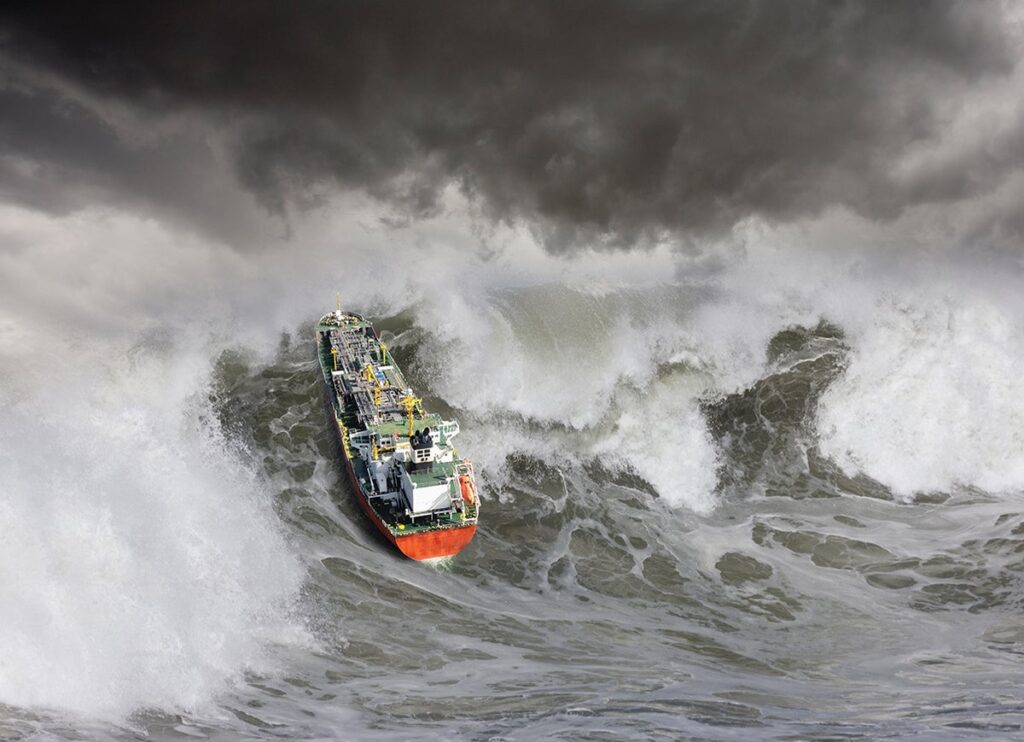November 13, 2025
3 min read
Dangerous Rogue Waves Aren’t Random—They’re Predictable
An 18-year dataset from the North Sea reveals that rogue waves are not freak accidents but particular products of ordinary swells stacking up—an insight that could make prediction possible
Under a hazy gray sky on the first day of 1995, the Draupner natural gas platform in the North Sea was struck by something that had long been relegated to maritime folklore: an 84-foot wall of water that hurled massive equipment across the deck and warped steel supports. The “Draupner wave” provided the first hard evidence that rogue waves were very real.
Three decades later scientists have unraveled some of the physics behind these anomalies. A recent analysis of 27,505 North Sea wave measurements, recorded over 18 years by laser sensors on an oil and gas platform, reveals how ocean waves’ quirky natural physics can produce a lone giant when multiple series (or “trains”) of waves intersect. The study, published in Scientific Reports, describes how this phenomenon can amplify a specific wave’s height compared with that of its neighbors. It also identifies a distinct “fingerprint” in the wave data—a repeating interference pattern that appears when two or more wave trains converge and reinforce one another—signaling when a rogue giant is most likely to emerge.
If scientists can detect these signatures early, extreme waves may change from unpredictable terrors into forecastable hazards. “Our civilization critically depends on shipping and offshore activities, and there is a massive international research effort aimed at understanding rogue waves,” says Keele University physical oceanographer Victor Shrira, who was not involved in the study. “Even the largest vessels and structures are not immune.”
On supporting science journalism
If you’re enjoying this article, consider supporting our award-winning journalism by subscribing. By purchasing a subscription you are helping to ensure the future of impactful stories about the discoveries and ideas shaping our world today.
Crucially, the new study helped to clarify what rogue waves are not. Researchers have often generated them in laboratories by inducing “modulational instability”: funneling artificial waves into narrow channels until they pile up catastrophically. Study senior author Francesco Fedele, an applied mathematician at the Georgia Institute of Technology, has revised these models in past work—and his findings suggest this lab process doesn’t explain what happens in the open ocean.
“Imagine a stadium crowd leaving through a long, narrow hallway,” Fedele says. “People at the back push forward, and some even climb over others, piling up in the crush,” he says. “That’s like a rogue wave in a wave tank. But if the stadium doors open onto a wide field, people spread out, and there’s no pileup. That’s the open ocean—rogue waves there don’t follow the same physics.”
Instead rogue waves involve a subtle quirk of nature. Real oceanic waves aren’t perfectly smooth sine curves; their peaks tend to grow steeper and sharper while their valleys become broader and flatter. Scientists call this built-in lopsidedness “bound-wave asymmetry,” and they have known about it since at least the 1980s but often dismissed it as a minor detail, according to Fedele. The new analysis suggests that when swells from several wave trains overlap in certain patterns, these sharpened crests can stack dramatically to build a single, towering wall of water—and the study also offers a measurable precursor pattern to this type of stacking.
According to the new research, detecting a particular fingerprint of swells that can lead up to a rogue wave could help scientists and mariners predict these monsters up to a minute before they strike. Such signatures have been spotted in newer data: in one North Sea storm in 2023, for example, cameras captured a 55-foot wave whose growth could be traced to those telltale interference patterns.
“I believe this study can be a further step in predicting rogue waves and helping vessels that may be exposed to them,” says Coral Moreno, an engineer at marine logistics company EDT Offshore, who was not involved in the study. She also suggests a widespread array of floats or buoys could be used to gather even more long-term data for prediction. The study researchers hope that as artificial intelligence, data collection and satellites improve, they will be able to detect these fingerprints across the world’s oceans—turning what once seemed like freak accidents into something reliably predictable.
It’s Time to Stand Up for Science
If you enjoyed this article, I’d like to ask for your support. Scientific American has served as an advocate for science and industry for 180 years, and right now may be the most critical moment in that two-century history.
I’ve been a Scientific American subscriber since I was 12 years old, and it helped shape the way I look at the world. SciAm always educates and delights me, and inspires a sense of awe for our vast, beautiful universe. I hope it does that for you, too.
If you subscribe to Scientific American, you help ensure that our coverage is centered on meaningful research and discovery; that we have the resources to report on the decisions that threaten labs across the U.S.; and that we support both budding and working scientists at a time when the value of science itself too often goes unrecognized.
In return, you get essential news, captivating podcasts, brilliant infographics, can’t-miss newsletters, must-watch videos, challenging games, and the science world’s best writing and reporting. You can even gift someone a subscription.
There has never been a more important time for us to stand up and show why science matters. I hope you’ll support us in that mission.

